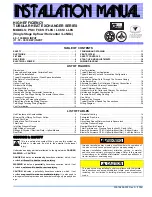
Appendix A - Determining Your Oil Pattern
400-294-002
Rev. Date: 01/07
A-3
The table below lists the checks you should perform to ensure the Express is applying the
amount of oil you want in the pattern you want. For each check, the table also lists where
to get information for changing the Express to the settings for your lanes. If you find none
of the problems listed below, you don’t need to make any adjustments to the factory
settings.
Dry spots in the oiled
area (from depressions,
undulating lane
surfaces, etc.)
If there are some dry spots
but
the rest of the lane has the
amount of oil you want, you can increase the buffer brush
pressure. This will not affect the amount of oil applied in the
oiled area only how hard the brush presses against the lane
surface. Keep in mind that increasing the buffer brush
pressure shortens the life of the buffer brush and puts undue
strain on the buffer motor. For information about checking
and changing the buffer brush pressure refer to the
Maintenance section.
If there are some dry spots
and
the rest of the lane does not
have the amount of oil you want, you may need to change the
wicking foams to one with higher output. For information
about this, refer to the Creating Oil Output Patterns in this
appendix. If changing the wicking foams does not eliminate
the problem, you can increase the buffer brush pressure but,
as explained in the paragraph above, it will affect the life of the
buffer brush, and the buffer motor. For information about
checking and testing the buffer brush, refer to the
Maintenance section.
Washboard Pattern In
The Oiled Area
This indicates one of three things: the buffer brush pressure
is not consistent across the lane, the oil output is too low, or
the buffer brush pressure needs to be increased.
Test the buffer brush pressure across the entire width of the
brush. The pressure should be at the same point between B
and C on the Buffer Pressure Adjustment Tool at each place
you test on the buffer brush. If they are not, adjust the buffer
brush pressure until the pressure is the same across the width
of the brush. For information about measuring the pressure
and adjusting the buffer brush pressure, refer to the
Maintenance section. Condition the lane after making the
adjustments to see if the adjustments eliminate the problem.
If the pressure is the same across the width of the brush and
the washboard pattern occurs, check the amount of oil applied
to the lane. If you want more oil, change the wicking foams to
a higher output. For information about this, refer to the
Creating Oil Output Patterns later in this appendix. Condition
Содержание Express 294-115-200
Страница 2: ......
Страница 4: ...ii...
Страница 6: ...iv...
Страница 80: ...Troubleshooting 4 10 Rev Date 01 07 400 294 002 This page intentionally left blank...
Страница 83: ...Parts 400 294 002 Rev Date 01 07 5 3 MISCELLANEOUS...
Страница 85: ...Parts 400 294 002 Rev Date 01 07 5 5 294 115 116 Wiring Diagram...
Страница 87: ...Parts 400 294 002 Rev Date 01 07 5 7 FRAME and BODY...
Страница 107: ...Parts 400 294 002 Rev Date 01 07 5 27 VACHEAD and CLEANING...
Страница 117: ...Parts 400 294 002 Rev Date 01 07 5 37 CONDITIONING Oiling and Buffing...












































